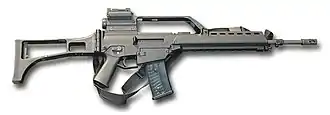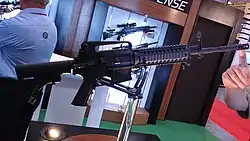Presidential Security Group
The Presidential Security Group, shortened as PSG,[1][Note 1] is a Philippine close protection agency. It is the primary agency concerned with providing close-in security and escort to the President of the Philippines, their immediate families, former presidents of the Philippines as well as visiting heads of state.
| Presidential Security Group | |
|---|---|
.svg.png.webp) Coat of Arms of the PSG | |
| Active | June 23, 1898 – present |
| Country | |
| Branch | Army, Navy, Air Force, Marines, Coast Guard, and Police. |
| Role |
|
| Size | 1 Brigade/Regiment, 3 Battalions. Total is 4000+ soldiers, police, coast guard and civilian personnel |
| Part of | Armed Forces of the Philippines |
| Garrison/HQ | Malacañang Park, Malacañang Palace, Manila |
| Nickname(s) | PSG, The President's Guards, Presidential Guards, Filipino Secret Service, Men in Barong, PSG Troopers |
| Motto(s) | Integrity, Service, Excellence |
| Mascot(s) | Eagle |
| Anniversaries | June 23 |
| Decorations | Presidential Streamer Award, Philippine Republic Presidential Unit Citation Badge |
| Website | http://psgtroopers.com/2017/ |
| Commanders | |
| Current commander | BGen. Jesus Nelson B. Morales, PAF |
| Notable commanders |
|
| Insignia | |
| Unit Patch | PSG Badge |

The PSG is stationed at Malacañang Palace, the official residence of the president. Members of the PSG also accompany the president on both domestic and overseas trips.
History
While the present-day force was established in 1987, the protection of the president and the presidential family has always been the duty of the Armed Forces of the Philippines since 1897.
In June 23, 1898, A guard unit called as the "Cuerpo de la Guardia Presidencial" (Presidential Guard Corps) was raised at the time to protect the first official president, Emilio Aguinaldo, from attempts on his life, composed of a presidential cavalry squadron and artillery batteries, reinforced with multiple guards infantry battalions all under the command of Major Geronimo Gatmaitan, which provided the protection of President Aguinaldo and his family.[2] Like today's PSG, they wore rayadillo uniforms, but with straw hats.
In 1936, the 1st Cavalry Regiment of the 1st Infantry Division, Philippine Army, raised the same year, was tasked with defending President Manuel Quezon, his family, and the palace complex. They were joined by a guards company in 1938 to reinforce the President's security.
During the Second World War, units of the occupying Imperial Japanese Army initially took over guard duties at the palace, only to be replaced by an all-Filipino guard battalion at the insistence of President José P. Laurel. At war's end, it was in turn replaced by the AFP Presidential Guards Battalion under the orders of President Sergio Osmeña. The PSG of today traces its origins to 1950 when a presidential security unit was founded under the orders of President Elpidio Quirino as the secret service and protective unit of the state presidency, the First Family, and Malacañang Palace, under the control of the Philippine Constabulary (then the Secret Service of Malacañang Palace and later the Presidential Security Force and Presidential Security Agency and Presidential Security Command).
When President Corazon Aquino was sworn in as president, she gave the order to disband the PSC and replace with the PSG.[3] The PSG, then as in the present, has always included both civilian agents and seconded servicemen from the Armed Forces.
The PSG launched the PSG Troopers website on February 10, 2017, as part of an effort to improve public relations.[4] Information concerning the president's security arrangements are considered as classified.[4]
Four PSG officers were wounded in an encounter with New People's Army guerillas in Arakan, North Cotabato after they were spotted running a fake vehicle checkpoint.[5]
On September 26, 2017, a PSG officer was found dead inside the Malacañang complex with a gunshot wound to the chest.[6]
Role
The role of the PSG is tasked with:[7]
- Providing security to:
- The president and their immediate family.
- The president-elect and their immediate family.
- Visiting heads of states or diplomats and Cabinet members and their families travelling with them and other guests.
- Visitors of the Presidential Museum and Library.
- Providing escort security for them at all times.
- Securing the president residences, offices, and places of engagements.
- Surveillance and monitoring activities.
- Performing state protocol duties including honor guard duties.
- Crowd Control.
The Presidential Security Group also have other functions, such as providing support to other government agencies. They assist the AFP and PNP in its anti-organized-crime and corruption undertakings, usually authorized by the Office of the President. They also conduct community service efforts in local communities, and maintain and secure all facilities and transportation assets used by the offices of the president and vice president in doing its regular and non-regular functions.[8] The role of the PSG to secure the Vice President and it's immediate family is transferred to the newly created Vice Presidential Security and Protection Group (VPSPG).
Organization
The following are organized under the PSG as of 2010:[9][10]
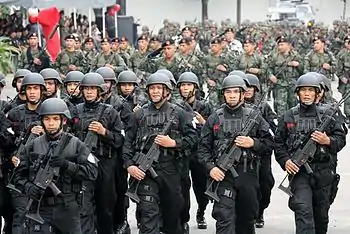
Leadership
- Commander-in-Chief: President Bongbong Marcos
- Secretary of National Defense: Atty. Gilberto C. Teodoro, PAF (Res.)
- Commander, Presidential Security Group: BGen. Jesus Nelson B. Morales, PAF
Key Personnel
- Commander, either a Colonel or Brigadier General
- Chief of Staff
- Special Reaction Unit Commander
- Commanding Officers
- Headquarters and Headquarters Service Battalion
- Security Battalion
- Presidential Escorts Battalion
- Presidential Guards Battalion
Units

- Headquarters & Headquarters Service Battalion
- Presidential Escorts - the actual personnel accompanying the President and his/her immediate family
- Guard Battalion
- Security Battalion
- Special Reaction Unit / K9 Unit
- PSG Station Hospital
- PSG Dental Dispensary
- Presidential Intelligence Company
- PSG Training School
- PSG Band
Recruitment
Agents are usually personnel from the Armed Forces of the Philippines, Philippine National Police and Philippine Coast Guard. However, there are a few civilian personnel acting as support units.
Military and police personnel serving in the PSG retain the ranks and insignia of their service which are worn in almost all orders of dress.
Equipment
PSG members are known to carry assorted firearms, some known firearms include:
The PSG utilizes Motorola trunked two-way radios with encryption capability.[12]
Vehicles
The PSG currently uses a fleet of vehicles, ranging from motorcycles; armored modified sedans and mid-sized vehicles; and armored personnel carriers.


_%E2%80%93_Frontansicht%252C_31._Dezember_2012%252C_D%C3%BCsseldorf.jpg.webp)

_(front)%252C_Jakarta.jpg.webp)

.jpg.webp)
_Sahara_wagon_(2011-11-18)_01.jpg.webp)
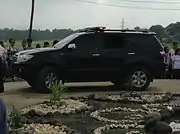 An unmarked Toyota Fortuner with a lightbar siren mounted on top of the SUV
An unmarked Toyota Fortuner with a lightbar siren mounted on top of the SUV
_van_01.jpg.webp)

_Cargo_Van_4.6L_front_1.23.19.jpg.webp)
 Philippine Army M113 armored personnel carrier
Philippine Army M113 armored personnel carrier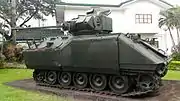 Philippine Army AIFV
Philippine Army AIFV Philippine Army Cadillac Gage Commando
Philippine Army Cadillac Gage Commando
References
- http://psg.mil.ph/ PSG Official Page
- "Presidential Security Group - History". globalsecurity.org. n.d. Retrieved July 12, 2023.
- "To reacquiant with the public, Presidential Security Group unveils website - Newsbytes Philippines". Archived from the original on April 18, 2018. Retrieved April 18, 2018.
- Ranada, Pia (February 10, 2017). "Presidential Security Group launches website". Rappler.
- Admin, PSG Troopers Website (July 19, 2017). "PSG encounters NPA at Arakan North Cotabato".
- Corrales, Nestor (September 26, 2017). "PSG officer found dead in Malacañang complex". newsinfo.inquirer.net.
- ""PSG" (Documentary by Sandra Aguinaldo)". GMA News. January 7, 2011. Retrieved July 16, 2011.
- "FEATURE | Former PH presidents given 8 security personnel".
- "NGA" (PDF). www.coa.gov.ph. 2010. Retrieved November 4, 2019.
- Admin, PSG Troopers Website (July 5, 2018). "121 Years of Selfless Service and Dedication to Duty".
- "Develop Philippine arms industry, group urges". philstar.com.
- "Philippine Daily Inquirer - Google News Archive Search". news.google.com. Retrieved July 1, 2016.


_modified.png.webp)

